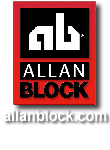Retaining Walls with Geogrid
What is Geogrid?
Geogrids are flexible, synthetic meshes which are manufactured specifically for slope stabilization and earth retention. These “grids” are available in a variety of materials, sizes and strengths. They can be made of high tensile strength plastics or woven polyester yarns and are typically packaged at the factory in rolls.
See the importance of reinforcement in your retaining wall with this sand castle demonstration.
Use the Soil Reinforcement Chart to determine the size of AB Grid you will need and how many layers your retaining wall requires.
How Grid Works
The sand castle test takes two cylinders of soil and applies vertical force to see how the soil performs. The first cylinder is just compacted material. The second is also compacted material with the addition of mesh screens to simulate the use of geogrid reinforcement. Learn more about how grid works...
Install Reinforcement
If you are building with AB Fieldstone that uses recycled materials, go to Fieldstone installation
For AB, AB Aztec & AB Europa Walls
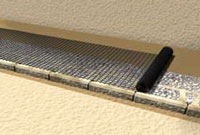
Install AB Reinforcement Grid

Install the next course of blocks

Backfill over grid and compact

Install next course of blocks and geogrid
- Once the base course is complete, begin installing the first layer of AB Reinforcement Grid. When using AB, AB Aztec or the AB Europa Collection, begin by placing the edge of the geogrid against the back of the raised front lip and rolling it out along the retaining wall. For AB Fieldstone, place the edge of the geogrid in the middle of the facing unit. Always refer to your approved plans for exact size and location.
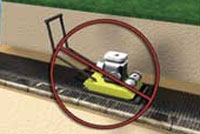
Never compact directly on top of grid
- Stack the next course of blocks so that the vertical seams are offset from the blocks below by at least 1/4 the length of the block.
- Sight down the retaining wall line to check for alignment. Blocks may be adjusted slightly to form straight lines or smooth flowing curves.
- Pull on the back of the geogrid to remove any slack. If necessary, stake it in place. Never drive or compact directly on the geogrid. This will cause damage to the geogrid.
Backfilling and Compaction
- Install wall rock in the block cores and 12 in. (300 mm) behind the block. Use infill or approved on-site soils to backfill behind the wall rock to the height of the block.
- The wall rock and infill soils behind the retaining wall must be properly compacted using a plate compactor. Compact in lifts of 8 in. (200 mm) or less, this time starting on the block and working in a path that runs parallel to the block and towards the back of the excavated area. Always make a minimum of two passes with a plate compactor. Compaction should be continued to achieve solid, movement-free soil.
- Remove all excess material from the top surface of all blocks. This prepares a clean, smooth surface for placement of the next course.
Additional Courses
- Continue installing your next courses of block using the steps shown above. Per your approved plans,install geogrid on every other course of the retaining wall.
- Using these steps complete the retaining wall to the desired height. On the last course, fill behind the blocks with organic soils in place of infill or approved on-site soils. This will assist in any plantings above the retaining wall and also to direct water from running behind the blocks. More information on finishing your retaining wall.
For AB Fieldstone Walls
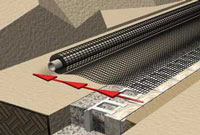
Roll Out Geogrid
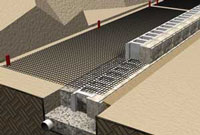
Stack the Next Course of Blocks
Installing Geogrid for AB Fieldstone
Refer to the approved plans for placement of geogrid; this example starts on top of the base course.
- Cut sections of geogrid to specified lengths per the project’s approved plans. Check manufacturer’s grid specifications for strength, and roll or machine direction.
- After the base course of blocks has been installed, roll out the geogrid reinforcement starting in the middle of the AB Fieldstone facing unit and extending back to the excavated area.
- Stack the next course of block (facing and anchoring unit) so the blocks are offset from the blocks below. Each new course should be positioned with the vertical seams are offset by at least 3 in. (75 mm) or 1/4 the length of the block.
- Pull on the back of the geogrid to remove any slack. Stake in place before installing wall rock and approved infill soils.
- Never operate compaction equipment directly on geogrid.

